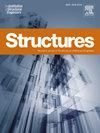意大利预规范钢筋混凝土建筑的抗震性能通过当地干预:易碎性曲线和故障率
IF 4.3
2区 工程技术
Q1 ENGINEERING, CIVIL
引用次数: 0
摘要
现有的意大利钢筋混凝土(RC)建筑表现出明显的地震脆弱性。根据意大利建筑规范(Rischio Implicito secondo le Norme Tecniche per le Costruzioni, RINTC)进行的国家项目隐含风险先前的工作表明,70年代以前的结构的地震故障率高于70年代 或80年代至90年代 的建筑物,特别是在倒塌时,主要是由于剪切破坏的发生。因此,这些建筑需要大量的改造工作。这项工作调查了70年前钢筋混凝土建筑抗震性能的潜在改进,特别是解决了钢筋混凝土构件(包括梁柱节点和深柱)的所有(非常)限制剪切破坏。改造设计的目的是增加建成容量,以满足新设计的建筑物在生命安全限制状态下的要求,仅根据意大利现有建筑物的规范规定。为了对地震缓解框架提供有价值的见解,考虑了一种普遍采用的、符合现行规范要求的具有成本效益的战略。该策略基于当地的干预措施,旨在加强所考虑的建筑,而不会显著改变其横向刚度。通过对仅为重力荷载(GLD)或根据过时的地震规范(SLD)设计的3层和6层建筑的非线性分析,评估了该策略的有效性。已经实施了精细的建模策略,也包括砌体填充物的存在。最后获得了两个性能级别(即全局倒塌,GC和可用性-防止损坏,UPD)的易碎性曲线和故障率,并与相关已建成建筑进行比较,以量化地震改进。通过采用局部策略和选择改造技术,发现UPD的故障率没有显著变化。然而,GC的抗震性能得到了显著改善,特别是对于那些按照过时的抗震规范设计的建筑。本文章由计算机程序翻译,如有差异,请以英文原文为准。
Seismic performance of Italian pre-code RC buildings strengthened via local interventions: Fragility curves and failure rates
The existing Italian Reinforced Concrete (RC) building stock exhibits a significant seismic vulnerability. Previous works conducted under the national project Implicit Risk according to the Italian Building Codes (Rischio Implicito secondo le Norme Tecniche per le Costruzioni, RINTC) have demonstrated that seismic failure rates of pre-70 structures are higher than those of ‘70 s or ‘80s-‘90 s buildings, especially at collapse and mainly due to the occurrence of shear failures. Extensive retrofitting efforts are, thus, required for these buildings. This work investigates the potential improvement in seismic performance of pre-70 RC buildings by particularly addressing all the (very) limiting shear failures in RC members, including beam-column joints and squat columns. The retrofitting design aims at increasing the as-built capacity to meet that requested for newly designed buildings at the Life Safety Limit State, only, according to the Italian code prescriptions about existing buildings. In order to provide valuable insights into the seismic mitigation framework, a commonly adopted, cost-effective strategy, compliant with the current code requirements, has been considered. This strategy is based on local interventions designed to strengthen the considered buildings without significantly modifying their lateral stiffness. The effectiveness of this strategy is evaluated through nonlinear analyses of 3- and 6-storey buildings designed for gravity loads only (GLD) or according to obsolete seismic codes (SLD). Refined modelling strategies have been implemented, also including the presence of masonry infills. Fragility curves and failure rates have been lastly obtained for two performance levels (i.e. Global Collapse, GC, and Usability-Preventing Damage, UPD), and compared with the relevant as-built buildings to quantify the seismic improvement. As a result of the adopted local strategy and the selected retrofitting techniques, it is found that failure rates at UPD do not change significantly. However, the seismic performance at GC improves remarkably, particularly for buildings designed in compliance with outdated seismic codes.
求助全文
通过发布文献求助,成功后即可免费获取论文全文。
去求助
来源期刊

Structures
Engineering-Architecture
CiteScore
5.70
自引率
17.10%
发文量
1187
期刊介绍:
Structures aims to publish internationally-leading research across the full breadth of structural engineering. Papers for Structures are particularly welcome in which high-quality research will benefit from wide readership of academics and practitioners such that not only high citation rates but also tangible industrial-related pathways to impact are achieved.
 求助内容:
求助内容: 应助结果提醒方式:
应助结果提醒方式:


